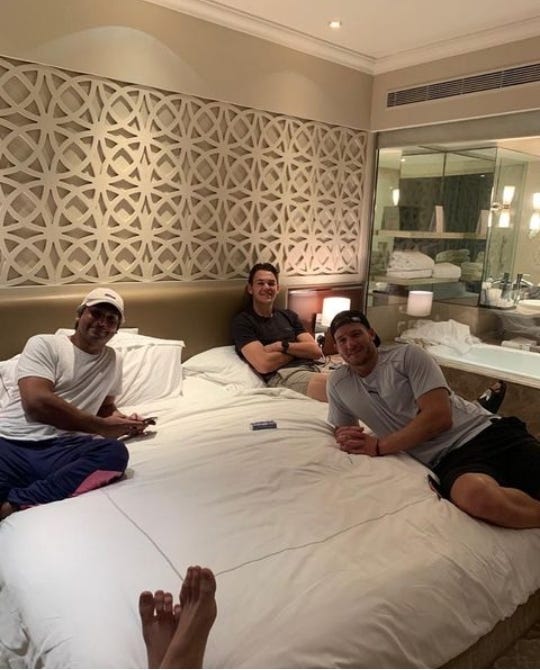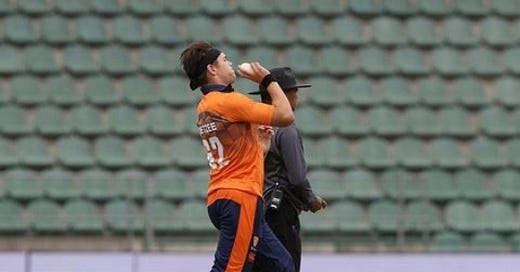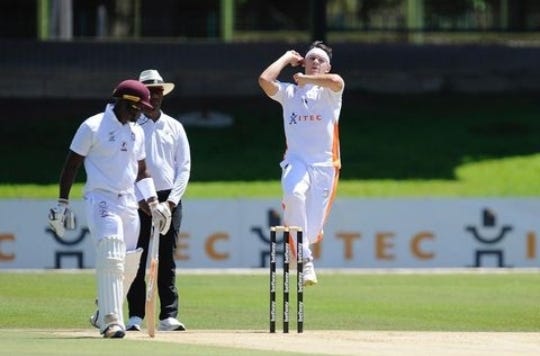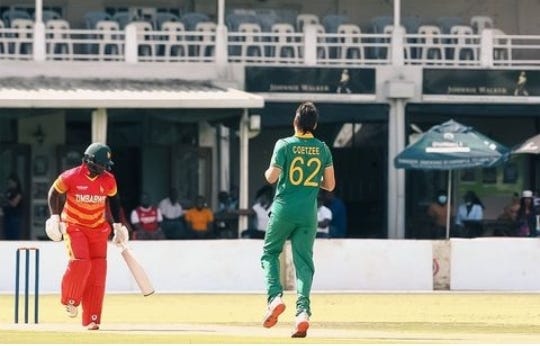UNCAPPED PICKS: Gerald Coetzee
The “Uncapped Picks” series continues with a new piece, an essay on Gerald Coetzee. “Uncapped Picks”, as the name suggests, features the six uncapped players picked by SA20 franchises before the auction. These pieces are designed to bring these incredible players closer to you, the fans. Draw the curtain and allow you to look into their world. We’ll have a new “Uncapped Picks” essay over the next few weeks. It should be really fun. Thanks, as always, for your support!
No. 1 Ottniel Baartman
No. 2 Dewald Brevis
“He walks into every team meeting with a notebook and is almost always the one player with the most questions about the opposition, game plans and everything else. He builds his little blocks…” Allan Donald says of Gerald Coetzee.
If you are not yet a subscriber of Stumped!, join more than a thousand other professional athletes & ex-pros, coaches, commentators & analysts and casual sports fans that receive the newsletter in their inbox each week — it’s free:
The Coetzees had two dogs. Their two dogs played cricket. They didn't bat. They didn't bowl. They fielded. Gerald and his older brother Petrus would place them in catching positions when they played backyard cricket.
Their version of backyard cricket was played in front of the garage door, which acted as wickets and backstop. The rules were simple, if you hit the ball over the fence it was six and out. If you knicked it back to the garage door, that was also out. The dogs were placed in catching positions and if they got their paws to an airborne ball, that was also out. One bounce and pawed was out. Gerald and Petrus tried to teach them to use their paws more often with little luck. But, dogs will be dogs and they often caught with their mouths.
There were no second chances, first-ball grace or anything of that nature. You had to be switched on from the moment you took guard.
The contests often lasted into the night and sometimes ended in tears. They were intense. The Coetzee siblings both have a competitive streak. Petrus brought his A-game every time and Gerald could never beat his brother. Being bigger and stronger helped Petrus a lot. Three years is a long time when you are young. And that rift lasts well into the later teenage years.
That is what made the contests enthralling, the intense competitiveness.
But, Petrus wasn't just bigger and stronger, he was also better skilled - as could be expected. He had had a headstart in the game. To top it off, Petrus simply had more talent. Playing up meant that Gerald had to be both skilful and creative.
Gerald was the younger sibling who just would not give up. He loved cricket too much to give up, even at an early age. Day after day, he grabbed their sparse gear and headed outside for another battle. It takes character to keep going to battle against someone with greater odds of winning. Gerald kept competing against Petrus for that slim one per cent possibility.
On 29 October 2022, Dewald Brevis hit a history-making 162 runs in a T20 match. Gerald was one of the bowlers that young Brevis put to the sword. The kind of assault he received that day can make one doubt their abilities, but Coetzee is tough enough to come back and be prepared to fail again in his quest to succeed next time. It takes heart to compete like that. He has character.
“The fun of sports is in competing, and if you get out-competed by someone, it's a good thing because it leaves you hungry and drives you to go back and get better,” he says.
Gerald Coetzee has guts/heart/backbone/balls - pick an anatomical metaphor of your choice. If you are South African, you can add liver to the list. You need plenty of that if you are a bowler.
This newsletter reaches more people because you share it with others. Here is a link to share it with others:
KFC mini-cricket is largely unstructured. Youngsters just pitch up and are drawn into teams that have fun with bats and balls. The score doesn’t mean much. When Coetzee was seven, he pitched up to a mini-cricket game. This was his first time at a KFC mini-cricket match.
Coetzee and a few other kids were taking a shy at the stumps as they waited for the game to begin. In a single motion, Coetzee picked up the ball and threw it at the stumps. Direct hit!
Sometimes you need a little serendipity. It happened that when Coetzee made the direct hit, an Under-9 coach had just arrived at the mini-cricket ground. The Under-9 F team was one player short and he needed someone with decent ability. The KFC mini-cricket coach pointed to Coetzee and told his colleague, “You can take that one.”
Coetzee’s mini-cricket career ended before it started. He was seven years old and once again he was the little kid hurling missiles and scoring runs against older opponents. Punching above his weight. But, he was where he was supposed to be. Petrus and his father had invested enough in him for him to be too good for mini-cricket. He was too good for the Under-9 Fs, but it was better than mini-cricket.
Coetzee was 11th of 11 on the Under-9 F team. He was one of the smaller kids and was in because the team needed 11 players. That didn't matter. Coetzee gave his Under-9 F team all he had. He swung the bat as hard as he could, bowled as fast as his spindly arms could allow and hustled in the field. There were kids with more talent in that team. Coetzee had more love for the game.
“I loved the game so much, I would spend more time practicing it, which gave me an advantage over other kids who maybe played cricket but didn't love it as much,” says Coetzee.
The love has not waned with growing up. It has intensified.
But, at seven, he was at the right place, at the right time. If he had spent a season playing mini-cricket, Coetzee would not have developed at the pace he did and might have taken longer to break into school teams. The F team gave him a way into the system, and he breezed through. Before the year was out, Coetzee had climbed through the ranks and was one of the players the school kept their eyes on.
A touch of serendipity.
Gerald’s school careers, primary and high school, flourished because he had the good fortune of coming across coaches who saw something special in him.
When Gerald Coetzee turned professional, his first coach was Allan Donald. He could not have had a better coach to help him navigate his first years as a professional cricketer. Coetzee has always looked up to Donald. Donald is the blueprint for tearaway quicks. Donald was a firebrand in his day and Coetzee was a firebrand in the present. He also played for the Knights and it is impossible to speak of the Knights without mentioning Donald.
During their time together at the Knights, Donald nurtured the younger pacer’s competitive spirit. He encouraged Coetzee to freely express himself on the field, bowl as fast as he liked and not worry about going for runs. When you have a bowler who can crank it up to 150km/h and also swing the ball at pace, you ask them to play fearless cricket. And that is what Donald did. He gave him the license to go fast.
Of course, Coetzee also possesses slower-ball deliveries. During the time he worked with Donald, he had two effective ones. He also had a back-of-the-hand slower ball, but he did not utilise it much because it gave him issues with his shoulder.
“Gerald’s greatest skill is his mindset, he is a fierce competitor,” says Donald. “One of the things that we worked on early on was getting him to stop thinking about the outcome and focusing on the next delivery.”
In May 2021, Coetzee flew to India to join the Rajasthan Royals as a replacement for Liam Livingstone, who had pulled out. He was still green. Coetzee had only eight T20s under his belt. The experience could have overwhelmed him had it not been for David Miller and Chris Morris. The Proteas duo made him feel at home. It was like having a second set of older brothers.
“It was an eye-opening experience. I got to work with Kumar Sangakkara for a bit and even watched one game from the sidelines,” says Coetzee.
That season of the IPL was scrapped before more matches were played. In a nutshell, Coetzee's trip to India had just been for him to train with the Rajasthan Royals, watch a match and meet Miller and Morris. The upside was that Morris took Coetzee under his wing and after that IPL season was scrapped, Morris maintained that role. He helped Coetzee to grow. Morris' advice has proved to be invaluable to Coetzee’s development.
Serendipity.

This Substack column exists thanks to patrons and readers that leave tips. Stumped! is wholly supported by Readers Like You. To keep the weekly posts coming and keep the lights on here, consider leaving a tip or supporting monthly on Patreon. You won’t regret it!
Don’t forget to share the post with friends.
In his autobiography, Rafael Nadal calls himself Clark Kent. Rafael Nadal the tennis player is unrecognisable from Rafael Nadal the man. The disconnect between the two Nadals is exceptional. When he strides onto a tennis court, Nadal is a glazed eye warrior clutching his racket like a Viking with his axe. That is Nadal’s Superman. Off the court, Nadal is a sensitive and warm individual; he is Clark Kent and Superman no longer.
“The simple action of wrapping on his bandana is so frighteningly intense; his eyes, far away, seem to see nothing that’s around him…” Nadal’s coach Rafael Roig shared the book. Rafael Nadal and his bandana remind one of old movies, especially from the 1980s and early 1990s, the moment the hero wore a headband you knew some bad people were about to get a serious butt-kicking.
Gerald Coetzee exudes similar vibes. When Coetzee wears his headband, you know he is about to crank up the speed. Headband Gerald is Gerald Coetzee’s alter ego; his Superman. It has to be expected, though, as Coetzee is a fan of Nadal’s.
“My role model and probably the person I admire the most as an athlete is Rafael Nadal. His work ethic, his alter ego, his willingness to compete, his eagerness to compete is everything I want to stand for as an athlete and then off the court, he is a genuine human, like a genuine human being with flaws who cares for people that isn't arrogant, like he's modest and humble in the way he speaks,” says Coetzee.
Dale Steyn is his cricketing hero. Fast bowling is an art and in Coetzee’s eyes, Steyn portrayed that art the best. He was the ultimate artist, cricket’s Michelangelo. Petrus Coetzee also makes the list. Petrus was the first role model Gerald Coetzee ever had and is partly responsible for a number of the behaviours Gerald developed as he grew up. Petrus is one of the people responsible for Gerald’s team-first mantra.
For most cricketers, their favourite match is when they starred for their team. Coetzee’s favourite match does not feature him in a starring role. He did not take a bag of wickets. He was not even the highest-wicket-taker in the match. Coetzee also did not score match-defining runs, in fact, he was dismissed for a duck. Their team was carried home by two youngsters after the entire top order had crumbled for noughts or low scores.
The match was an SA Schools T20 final between Hilton College, Lungi Ngidi’s former high school, and St. Andrews. It probably means so much to Coetzee because St. Andrews became the first Free State school to win the title. Coetzee will have more memorable matches that he will be a part of, his career is still young, but this match will always rank among the best ones for him.
“Gerald is the kind of player who will run through the wall for you,” says Allan Donald.
This newsletter reaches more people because you share it with others. Here is a link to share it with others:
Gerald Coetzee tried to contain his smile. He didn’t think the time was ripe to share the news he had just gotten, and his walking around with a beaming smile would make everyone curious. The exercise took a lot of effort because he was happy.
Here he was, touring with the Proteas and then receiving a call from Faf du Plessis to ask if he would be interested in joining the Joburg Super Kings as their uncapped pick. The Joburg Super Kings could have asked anyone from their staff to make the call, but du Plessis had chosen to do it himself. The gesture meant a lot to Coetzee.
Of course, it wasn’t just the gesture that made Coetzee excited. For the pacer, any opportunity to be part of a team like the Joburg Super Kings is a huge honour. He jumped at the opportunity, and Coetzee didn’t need any time to consider the offer.
There was a time when his career stumbled. Sometimes, as fast bowlers mature and grow into their bodies, they suffer injuries. That is because, as Mark Wood puts it, bowling fast is deeply unnatural. Essentially, it involves contorting the human body in a series of awkward ways, culminating in propelling a leather ball with a straight arm at speeds over 90mph.
“It’s like a rocket,” Wood explains in his book. “All of a sudden you have this build-up of energy and then everything's aligned.”
After turning professional, Coetzee suffered a couple of injuries that kept him on the sidelines for a bit. His second season was the worst. Coetzee’s injuries were not career-threatening, his body just didn’t recover quickly enough. His muscles took a little longer to heal than everyone else’s.
Coetzee went and invested money into improving his strength. That investment was followed by another followed up by another investment into rehabilitation. When he returned, he was stronger and fitter.
“After Faf’s call, I did not share the news with anyone,” says Coetzee. “My parents were the first people I shared the news with, but not immediately because you want to be careful. You never want to just share the news immediately.”
As he moved among his Proteas teammates, Coetzee kept his emotions concealed, but underneath he was proud of himself and knew his family would be over the moon. But, if he had decided to share the news immediately, the first person he would have probably called would have been his father. Gerald Coetzee wears shirt number 62 as a tribute to his father.
Oom Coetzee knew that his two sons were cricket-mad, and so, every single day, he showed up in the afternoon with a bag of bowling machine balls. He would perform throwdowns to his sons for hours each afternoon. Initially, they were not structured. He threw the balls and Gerald whacked them. Oom Coetzee did not want to put undue pressure on young Gerald. He just wanted the boy to have fun.
Petrus had the more structured throwdowns, being older.
“My dad is probably the most influential coach I've had in my career because he gave up his life to give me some support in mine,” says Gerald.
Oom Coetzee was born in 1962, and wearing the number 62 as a nod to the year his father was born, is Gerald’s humble way of showing his gratitude to his father. What Gerald’s father did not teach him was bowling. Gerald sort of grew into the craft. All his father did was provide support throughout. He fulfilled whatever role Gerald needed him to fulfil as the young pacer worked on his bowling.
Bowling is such an individually specific movement and his body sort of learned what needed to happen, and how it needed to move to execute the skills. He only started working on the technical aspects of bowling when he was older, during his time at St. Andrews, under the watchful eye of Gregg Hobson.
Like other bowlers, Coetzee ‘just’ knows when his rhythm is right and when it is not - no one can teach you that. “If your rhythm is out, the way you jump could be wrong. Your balance at the crease could be wrong and your energy through the crease could be wrong,” says Coetzee.
When you bowl at 150km/h and in the upper 140s, rhythm matters. And when your rhythm is right, you get the timing right and the ball just flies. Everything clicks and a bowler can tell by the way they land – ‘the speed of your run-up, the timing of your land and the timing of your head coming forward, your arm coming through. You know as soon as the ball's left your hand, literally within a millisecond – that's a fast one.’
Coetzee’s hope is that everything will click into place for him during the SA20 tournament.







